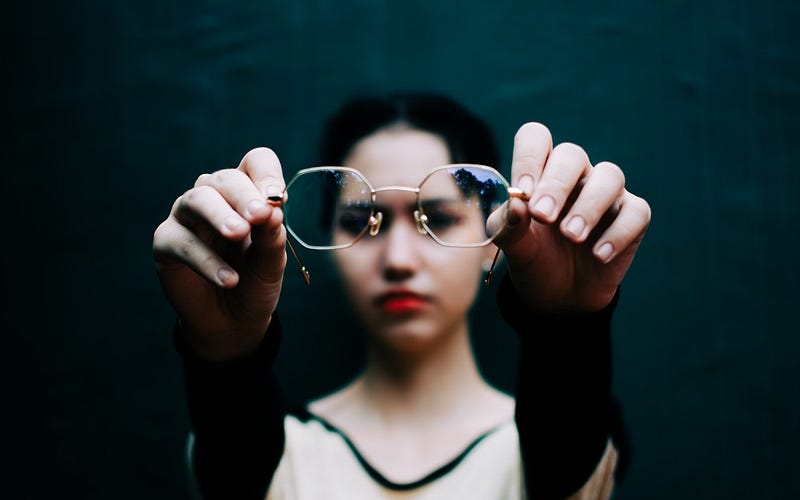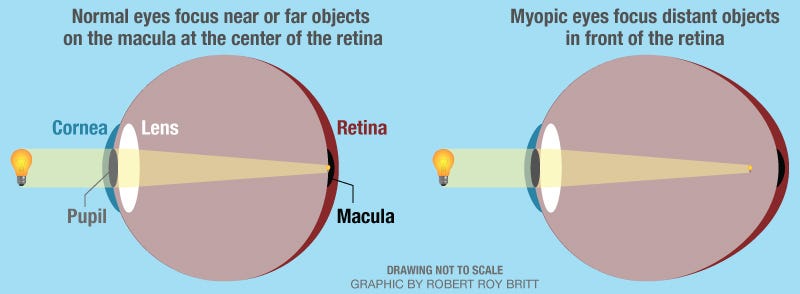Understanding Myopia: The Impact of Modern Living on Vision
Written on
The Rise of Myopia in Contemporary Society
Recent studies have unveiled alarming insights into the surging rates of myopia, or nearsightedness, suggesting that simple lifestyle adjustments could help alleviate this condition.

The phenomenon of myopia stems from an elongation of the eyeball, allowing for clear vision of nearby objects but causing distant images to blur. While wearing specialized glasses or contact lenses can manage this issue, myopia is linked to an increased risk of serious eye conditions such as glaucoma and macular degeneration, as well as potential blindness in later life. The relationship between myopia and sleep remains unclear, raising questions about whether one condition exacerbates the other, particularly in the context of excessive screen time.
A significant factor to consider is genetics; however, they alone cannot explain the drastic rise in myopia cases. In the United States, the prevalence of myopia has jumped from 25% in 1971 to over 40% today, with some developed Asian countries reporting rates as high as 80% among high school graduates. A study from the U.K. highlights that while 20% of individuals born between 1939 and 1944 were myopic, this figure rose to 29% for those born between 1965 and 1970. Interestingly, the onset of myopia is increasingly being observed in adults, despite it typically manifesting in childhood. Projections indicate that by 2050, half of the global population may experience myopia.

Children's developing eyes are particularly vulnerable to this elongation, meaning we may not fully understand the long-term consequences of this epidemic until today's youth reach old age. Lisa Ostrin, an optometrist at the University of Houston, noted this concern three years ago when discussing the myopia crisis.
A Shift in Lifestyle
Despite the unknowns surrounding myopia's causes, one thing is clear: humans have transitioned from an active, outdoor lifestyle to prolonged indoor sitting, often fixated on screens.
“There is robust evidence indicating that activities requiring close focus, such as reading, elevate the risk of myopia, while outdoor time appears to counteract this risk,” stated Dr. Jose-Manuel Alonso, a professor at the State University of New York’s College of Optometry. “However, the exact mechanism remains unclear, with various hypotheses lacking definitive proof.”
Dr. Alonso and his team conducted a study involving eight adults, some with normal vision and others with myopia. The participants engaged in two five-minute tasks: reading on a computer screen under standard lighting conditions and navigating a space with variable lighting, ranging from dim to much brighter than the screen. Eye movements, head movements, pupil size, and blink frequency were meticulously tracked.
The findings, published recently in the Journal of Vision, revealed that walking, compared to reading, enhanced eye movement frequency, pupil size changes, and blinking rates.
Exploring the Data
The results indicate that screen time and other close-up activities do not adequately activate the eye's "on pathways," which respond to light and brightness changes. These pathways are crucial for stabilizing visual perception during movement. Optimal stimulation occurs in outdoor settings where natural light can be significantly brighter than that emitted from screens.
“Our findings suggest that engaging in visual navigation outdoors, combined with exposure to bright light and high contrast, could prevent myopia progression,” Dr. Alonso explained. “In contrast, prolonged periods of low-contrast and dim lighting during close-up tasks are likely to exacerbate myopia.”
Dr. Eedy Mezer, a pediatric ophthalmologist representing the American Academy of Ophthalmology, pointed out some limitations in the study, noting that it did not directly compare reading on screens versus paper or assess outdoor conditions. “Future research could help validate the current study's hypothesis,” Mezer stated.
“In the meantime,” she advised, “children and teenagers should aim to minimize screen time, maintain a safe distance from screens, and prioritize outdoor activities over using smartphones or tablets.”
Given the significant amount of time spent on screens today, this advice applies to adults as well. Incorporating outdoor activities like walking, gardening, or sports can greatly enhance both physical health and sleep quality, potentially providing a renewed perspective on life.
The first video titled "Why is Everyone Going Blind? The UGLY TRUTH behind the myopia epidemic" delves into the underlying causes of myopia and its alarming rise in modern society.
The second video, "Myopia: A Modern Yet Reversible Disease — Todd Becker, M.S. (AHS14)," explores the potential reversibility of myopia and emphasizes lifestyle changes that can mitigate its effects.
Your support makes my health and wellness writing possible. For updates on my publications, you can subscribe to my email list or check out my book: Make Sleep Your Superpower: A Guide to Greater Health, Happiness & Productivity (available in paperback or Kindle).